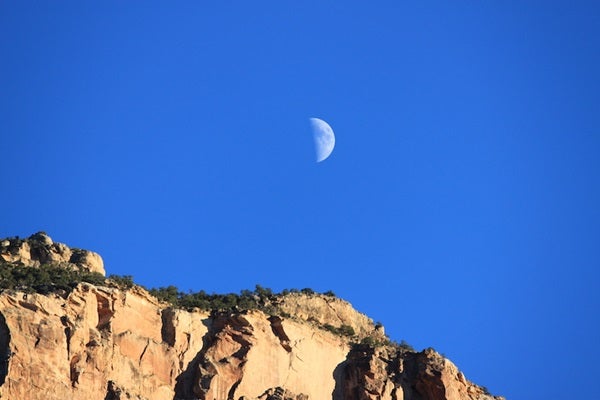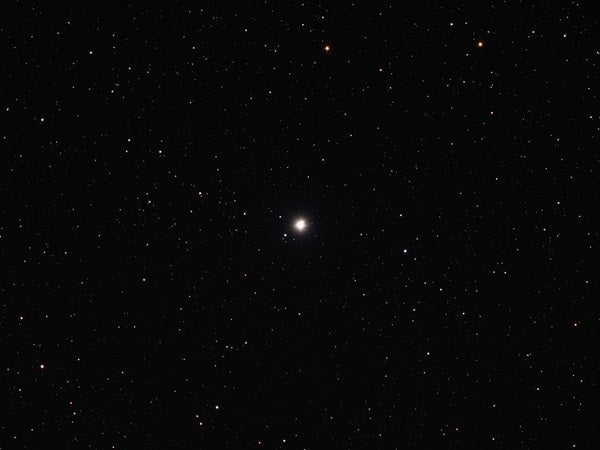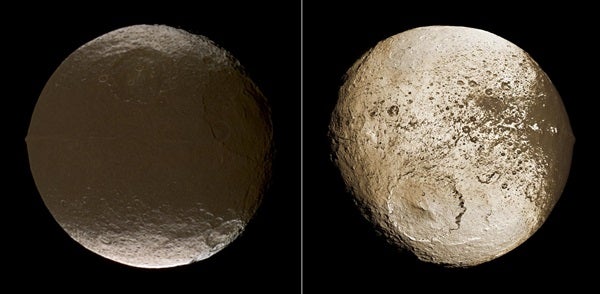First Quarter Moon occurs at 9:23 A.M. EDT and will be visible all evening, setting shortly after midnight tomorrow morning. The Moon tonight is in the southern constellation Capricornus, so for the most interesting views, look north instead, where the sky will be darkest. As night falls, Ursa Major sits with her paws on the ground, making the Big Dipper asterism, which comprises the tail and hindquarters of the bear, appear upright. Above it is the Little Dipper, the backside of Ursa Minor, which appears upside-down so that imaginary water pouring from the Little Dipper would land in the upturned bowl of its bigger counterpart.
The very end of the Little Dipper’s handle (and the Little Bear’s tail) is Polaris, the North Star. It’s the only star in the northern sky that appears not to move as Earth turns on its axis. If you visualize a ring in the sky with a radius equal to the distance between Polaris and the Big Dipper, within that ring you’ll find the circumpolar constellations, which are so close to the North Pole that they appear to rotate around it, rather than rise and set as straightforwardly as the other constellations. These circumpolar constellations include Draco, Cepheus, and Cassiopeia, as well as the lesser-known Camelopardalis and Lynx. Pick your favorite tonight and watch it circle the pole as the hours go by.
Sunrise*: 7:20 A.M.
Sunset: 6:08 P.M.
Moonrise: 2:41 P.M.
Moonset: —
Moon Phase: Waxing gibbous (52%)
*Times for sunrise, sunset, moonrise, and moonset are given in local time from 40° N 90° W. The Moon’s illumination is given at 12 P.M. local time from the same location.
Saturday, October 24
Although the Orionid meteor shower peaked a few days ago, you may still catch stray shower meteors early this morning after the Moon has set. The shower’s radiant is in Orion the Hunter, who rises before midnight and climbs higher in the sky as the hours tick toward sunrise.
Beside him are Gemini the Twins, whose brightest stars Castor and Pollux are easy to spot. As the constellation rises, white-hued Pollux is closer to the ground, while golden Castor sits to its upper left. By around 12:45 A.M. local time, Sirius has cleared the horizon. This blue-white star is the brightest in the Northern Hemisphere sky, although largely owing to its distance — a mere 8.6 light-years away.
Compare Sirius, whose magnitude is –1.45, with Rigel, Orion’s magnitude 0.18 left knee (on the right side of the constellation), which is more than 800 light-years away. Those magnitudes are the stars’ apparent magnitudes, which simply compare how bright they appear in the sky. But when scientists consider their absolute magnitudes, which compare how bright these stars would appear if placed at the same distance, Rigel would far outshine Sirius as the brighter star.
Sunrise: 7:21 A.M.
Sunset: 6:07 P.M.
Moonrise: 3:20 P.M.
Moonset: 12:12 A.M.
Moon Phase: Waxing gibbous (62%)
Mercury reaches inferior conjunction at 2 P.M. EDT, meaning at that time, it will sit directly between Earth and the Sun. Because of this configuration, the tiny planet isn’t currently visible; but don’t worry, it will appear in the morning sky next month.
Instead of planets, seek out the stars tonight — in particular, a pair of stars in Cassiopeia the Queen with the single name Achird (Eta [η] Cassiopeiae, or Eta Cas). Not part of the constellation’s famous W shape, Achird sits about 3° west-southwest of magnitude 2 Navi. Achird is a delight through a telescope, visible as a clear binary with a larger, brighter yellow luminary accompanied by a smaller, noticeably redder star to its northwest. The pair is separated by 13″, making them visible with just 50x magnification. The brighter component — a Sun-like, G-type star — is magnitude 3.4, while the dimmer star, a K-type dwarf, shines at 7.5. A planet around the G star would easily see that K dwarf in its skies, shining with the light of about five Full Moons.
Sunrise: 7:22 A.M.
Sunset: 6:05 P.M.
Moonrise: 3:52 P.M.
Moonset: 1:23 A.M.
Moon Phase: Waxing gibbous (71%)
Monday, October 26
Asteroid 471 Papagena, currently located in the constellation Cetus the Whale, reaches opposition at 2 A.M. EDT. At that time, the tiny world is about 40° high above the southwestern horizon, glowing at magnitude 9.5.
If you’re looking to spot Papagena, the nearest stellar signpost is Mira (Omicron [ο] Ceti), which sits 5° north-northwest of the asteroid. Mira is a famous star in its own right — this “wonderful” luminary is a variable star whose magnitude swings between 2 and 10 over the course of nearly 11 months. Its most recent peak in brightness was earlier this month. Careful, consistent observers can chart its changes by revisiting the star every one to two weeks and comparing its brightness with the stars around it. Binoculars or a telescope will do the trick, depending on your options and your location (i.e., the amount of light pollution).
Sunrise: 7:23 A.M.
Sunset: 6:04 P.M.
Moonrise: 4:20 P.M.
Moonset: 2:25 A.M.
Moon Phase: Waxing gibbous (80%)
Tuesday, October 27
It’s another early morning for observers, but well worth it to catch the Moon passing 4° south of Neptune at 2 A.M. EDT. The pair are in the constellation Aquarius, with two magnitude 4 stars — Psi1 (ψ1) and Phi (φ) Aquarii — between them. Neptune, at magnitude 7.8, requires some decent optical aid to see, especially with the gibbous Moon so close. Its 2″-wide, bluish disk will likely appear as a “flatter” star in your field of view.
The distant ice giant is currently nearly 30 astronomical units, or AU, from Earth. (One AU is the average Earth-Sun distance.) Despite its diminutive appearance through your optics, Neptune is actually 17 times more massive than Earth and nearly 4 times as wide; however, it is only 0.3 times as dense as our planet, owing to its icy, gassy composition when compared to our rocky home.
Sunrise: 7:24 A.M.
Sunset: 6:03 P.M.
Moonrise: 4:45 P.M.
Moonset: 3:26 A.M.
Moon Phase: Waxing gibbous (87%)
Like the Force, Saturn’s two-faced moon Iapetus has a light side and a dark side. Currently, that brighter side is turned toward Earth, making the tiny, icy moon a little easier to locate as it orbits the ringed planet.
Tonight, magnitude 0.6 Saturn sits about 5.5° east of magnitude –2.2 Jupiter; both are in the southwest among the stars of Sagittarius. Zoom in on Saturn with a telescope to pick out several of its moons — the largest and brightest, Titan, is just under 2′ southwest of the planet. Tenth-magnitude Tethys and Dione float east of the planet, with Dione the farther of the two. Rhea, also magnitude 10, is about 30″ due south of the eastern edge of the rings. Enceladus, a challenging magnitude 12, lies just 6″ northwest of Tethys.
Look due west of Saturn to find Iapetus, glowing near magnitude 10 and about three times farther from the planet’s disk than Titan. As its dark side rotates back into view next month, the moon will dim; the difference in brightness between its two hemispheres is a little more than a magnitude.
For a less-challenging set of satellites, swing over to Jupiter, where all four Galilean moons are on display. Only Callisto is currently east of the planet; on the western side, Ganymede, Io, and Europa line up (from closest to farthest). The orientation of the moons shows just how perpendicular Jupiter’s poles are to its orbital plane — the giant planet is tilted by a mere 3°, much less than Earth’s 23.5°.
Sunrise: 7:25 A.M.
Sunset: 6:02 P.M.
Moonrise: 5:09 P.M.
Moonset: 4:24 A.M.
Moon Phase: Waxing gibbous (92%)
Thursday, October 29
The Moon passes 3° south of Mars at noon EDT. By the time the pair has cleared the horizon around sunset, they’re just over 4° apart. You’ll find them in the east, rising as the sky grows darker, with Mars just to the upper right of the Moon. The Red Planet, still a bright beacon two weeks after opposition, glows at magnitude –2.2 and appears 20″ across.
By two hours after sunset, the face of Taurus the Bull is peeking above the horizon, with his bright red eye, Aldebaran, popping up shortly after. Look directly above the v of the Bull’s nose to find the Pleiades (M45) sparkling in the shape of a tiny dipper. Although this open cluster is often confused with the Little Dipper, its spoon shape is much smaller and more compact than the asterism, located in the north. The Pleiades is a young cluster containing several thousand stars and about 800 solar masses of material. With the naked eye, you may see as many as 12 of the cluster’s stars; binoculars and telescopes will bring out many more. If you’re an astroimager, turning your camera on the cluster is likely to reveal the nebulosity, or glowing gas, strung between the brightest stars.
Sunrise: 7:27 A.M.
Sunset: 6:00 P.M.
Moonrise: 5:32 P.M.
Moonset: 5:23 A.M.
Moon Phase: Waxing gibbous (97%)
Friday, October 30
The Moon reaches apogee, the farthest point from Earth in its orbit, at 2:45 P.M. EDT. It will then sit 252,522 miles (406,395 kilometers) from our planet. Our satellite is 99 percent lit and will delight Halloween revelers tomorrow as a Full Moon to light the spooky holiday.
The nearly Full Moon does, however, make the sky brighter and washes out dimmer stars and deep-sky objects. Tonight is a great night to search out some famous asterisms, though: the Square of Pegasus, the Big and Little Dippers, the Teapot in Sagittarius, and the w shape of Cassiopeia. Also still visible is the Summer Triangle, made up of the three bright stars Deneb, Altair, and Vega. High overhead during summer nights, the Triangle is now lower in the west around 8 P.M. local time. Over the next few months, its stars will set completely by sunset and the Triangle will disappear as the winter constellations come out in full force.
Sunrise: 7:28 A.M.
Sunset: 5:59 P.M.
Moonrise: 5:55 P.M.
Moonset: 6:21 A.M.
Moon Phase: Waxing gibbous (99%)













